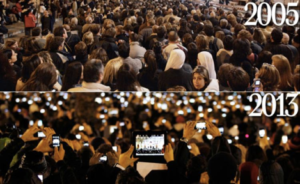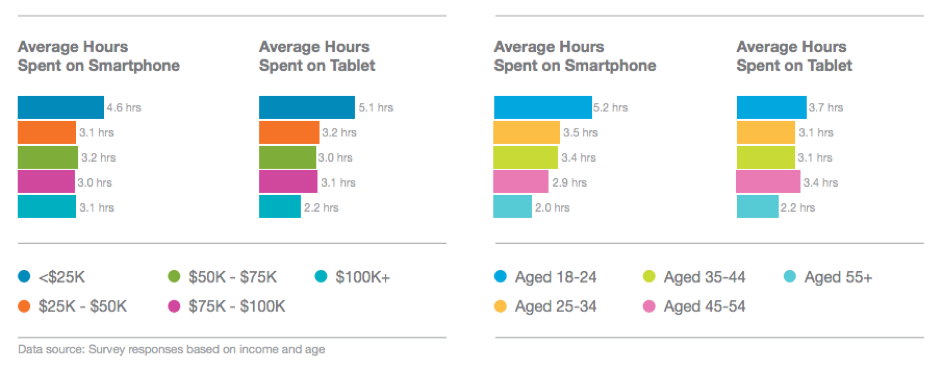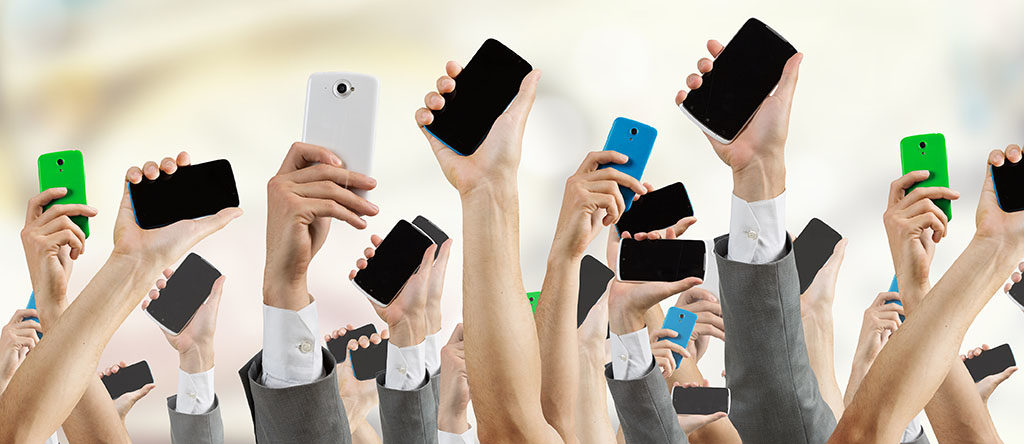Smartphones have literally changed the way we view the world in the last decade, as shown by the incredible contrast of these two pictures taken at St Peter’s Square in Rome of crowds gathering to witness the appointment of new Popes in 2005 and 2013.
 Given how glued to our screens we all now are, how can Hospitality operators turn this to their advantage for the fundamentally offline process of eating and drinking?
Given how glued to our screens we all now are, how can Hospitality operators turn this to their advantage for the fundamentally offline process of eating and drinking?
One of the first things we absolutely have to consider is whether all digital consumers created are equal when it comes to moving functions like order and pay on to mobile. It might be tempting for restaurants, coffee houses, bars and other Hospitality operators to lump all their digital consumers into one bucket and treat them the same. But what happens when you take a closer look at your mobile users? What are their expectations and motivations for going mobile and what are the subtler behavioural differences between those who would and wouldn’t use mobile in-store? How does this affect the way you market to them? Also, what lessons can we learn from Retail and Travel’s venture into mobile service? We’ve done the research and offer you an in-depth profile of your most digital-savvy customers right here!
Given that mobile is a veritable life saver for many Americans and even more so for Millennial Americans (with 44% saying they couldn’t make it a day without their phones!), let’s look at your guests’ intentions from a Hospitality perspective. The potential for mobile in this industry is boundless, this little device holds a wealth of opportunity for operators who dare to push the boundaries for the industry and take heed of the hard learned lessons from Travel and Retail’s mobile ambitions. From mobile ordering and mobile payment to marketing, loyalty and social – as a restaurant owner or other Hospitality operator, you’d be missing a serious trick if a comprehensive digital strategy wasn’t high on your marketing agenda.
Not only are your customers fully equipped to take advantage of any mobile service offering, they’re absolutely ready and willing. More than 52% of diners would use an electronic payment system, 41% would use a self-service ordering terminal is it was available, 39% would use an electronic ordering system including iPad menus and wine lists and 46% of consumers would use a restaurant’s smartphone app if available. These findings are comparable to other sectors too. In Travel for instance, 52% of travellers use apps at their final destination and of those, 75% are searching for restaurants!
Hospitality and Travel mobile usage lags behind Retail though with 90% of shoppers stating they use smartphones in store and 85% saying their m-commerce buying was steady or had increased vs. a year ago. One warning flag that Hospitality should take note of is that personal data security and poor user experiences (e.g. product images too small) were cited as major barriers to the further growth of mobile e-commerce. Further insights restaurant operators can capitalise on from Retail include the fact that 57% were more likely to shop at a store where in-store push notifications about deal and offers were available and 76% would be more likely to shop at a store with a mobile loyalty program.
Not only are customers more likely to choose you for your digital offerings but they’re more likely to spend a few quid extra too. A recent study by Deloitte found that 40% of frequent restaurant visitors prefer to order online and that they spend 26% more per online order at quick service restaurants and 13% more in casual and fast causal establishments – a significant factor when considering service aspects that affect your bottom line.
As well as the clear marketing opportunities mobile offers the industry, another reason why mobile lends itself to Hospitality so well is because of its social aspect. When looking at the digital social behaviours of your customers:
- 30% use social media to choose a restaurant
- Food is the 4th most popular topic on Pinterest with 5% of content
- There’s even a social network Yummi, exclusively devoted to all things food-related
- A study has found Instagramming your food makes it taste better!
So far we’ve worked out that smartphones are everywhere, customers want and expect a mobile-friendly experience and there’s a huge mobile marketing opportunity to be had when it comes to loyalty, location-specific campaigns and social; but how does your group of mobile-using customers break down in terms of income and age for example?

It seems those on a lower income spend a greater amount of time on their mobiles and mobile usage drops off the older you get. Looking at gender and, despite the shopping stereotypes, it seems men may be more digitally active when it comes to eCommerce. According to Zeendo, 13% of men vs. 8% of women have purchased food or drink on their mobile, 46% of men vs. 32% of women have used mobile for payment but this might be that women are 14% less likely to own a mobile phone than men.
What does all this mean for you?
- If you don’t have a mobile strategy, start thinking about one sooner rather than later and come prepared to consider the bigger picture. For example, how does mobile fit in with existing channels (e.g. web, kiosk, face-to-face service), how will you ensure a seamless experience (e.g. POS integration etc)?
- Focus on promoting mobile services to Millennials and Gen Z but don’t completely exclude older demographics, as our ‘Rise of the Silver Surfer’ blog uncovers, they’re far from digitally despondent!
- Use mobile loyalty and marketing tactics to engage and attract customers – the more personalised the campaign, the better. Perhaps keep in mind the gender differences when it comes of mCommerce and associated offers and promotions.
- Learn from Retail and pay careful attention to the user experience and security issues





